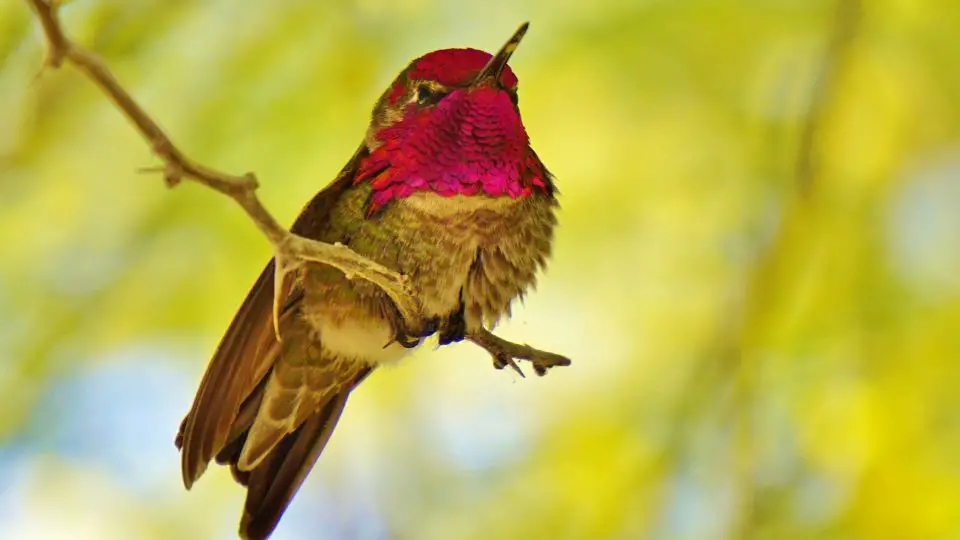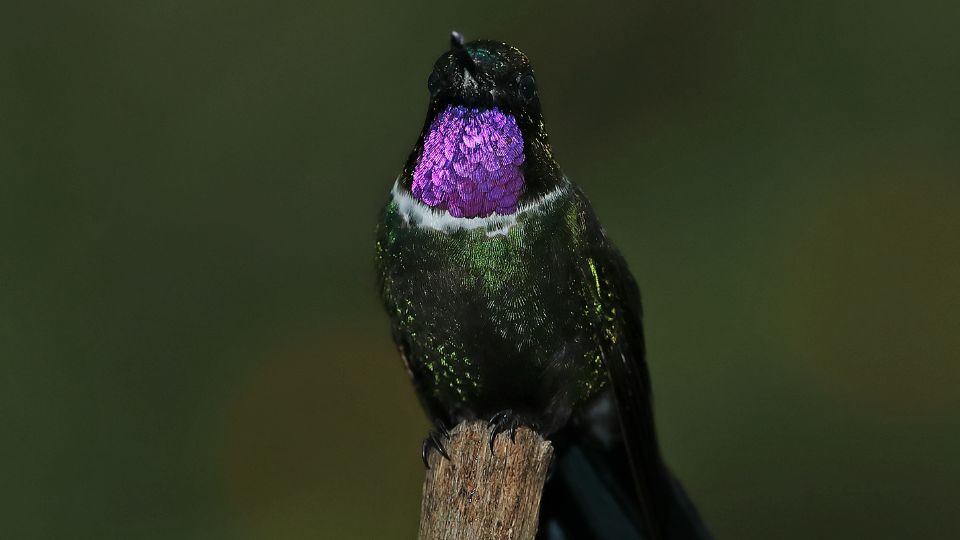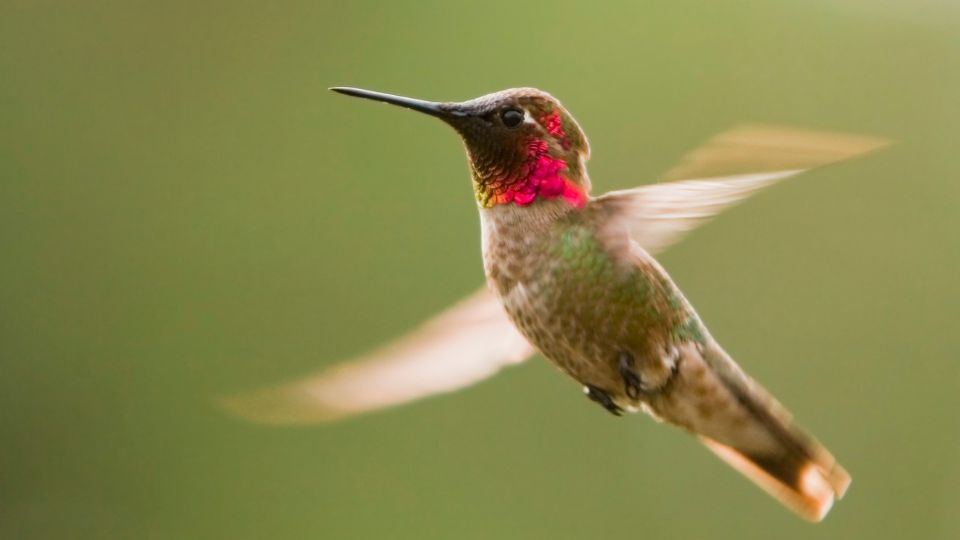To tell a male hummingbird apart from a female look at their gorgets or throat area, males typically have very colorful and iridescent plumage while females have neutral colors. Another telling feature is in the tail, adult males have the appearance of a forked tail, while females and juvenile males have rounded tails.
If you’re a fan of birdwatching, learning how to tell a male from a female hummingbird might be interesting. Luckily, telling male vs female hummingbirds is super easy.
If you notice hummingbirds fighting around the feeders, they’re likely males since they’re more aggressive. Males are also packed with colors, while females are neutral. Once the breeding season is over, you’ll see females nesting high up on the surrounding trees.
If you can get a good pair of binoculars from Amazon, you can also look to see the females at their nests and the colorful males that flutter by them. Here are four things to check.
Table of Contents
4 Steps to Tell Male from Female Hummingbirds
If you are new to birdwatching, being able to differentiate between hummingbirds can be confusing. To tell the gender of most hummingbirds, make a note of the following four differences.
Note the Size Difference
It may be hard to notice the size difference between two birds flying around at all times, but females are often slightly larger than males. Females are larger because they lay eggs, and their bodies should be able to support the whole nesting season and process.
Adult females are up to 25% larger than males. Adult males weigh about 0.08 oz to 0.13 oz (2.4 to 3.6 grams), while females are about 0.1 oz to 0.016 oz (2.8 to 4.5 grams).
Even though females are larger than males, male hummingbirds tend to have longer and pointier tails. The tail length is crucial for attracting the female, who has a shorter and rounder tail. Males with longer tail feathers have higher chances of scoring a mate.
Listen to the Sounds
This bird species could be pretty loud for its size. However, the reasons for chirping differ. Males will likely chirp and squeal to scare other males away from their territory and/or feeder. Additionally, males could also chirp during their courtship display in an attempt to get the female to mate with them.
Females will do so to protect the nest if an intruder is nearby. Females will typically display this behavior at their nesting site.
Watch the Behavior
When you are sitting to get to know every hummingbird in your yard. Here you can start to note the differences in female and male behavior. Males will often be more aggressive, often monopolizing the feeder all to themselves. Females will perch or rest on most feeders, frequently feeding if the male allows it.
Courtship displays are among the best ways to tell males from females. Once the breeding season starts, males will do their dances and try to get females interested in them. They’ll fly high up in the air and suddenly dive right in front of the female. They’ll also chirp and show off while the female observes them.
Besides the dances, males will defend feeding and breeding grounds by fighting. On the other hand, if you see a hummingbird chirping on some high branches, it’s likely a female defending the hummingbird nest and younglings.
Additionally, if you see a bird continuously checking out one spot and making a nest, it’s the female hummingbird. Males aren’t involved in nesting so that females will do all the work.
Look at the Colors
The most notable difference is that the male hummingbird has a much more colorful gorget, back, and wings than the female. They use their bright colors to lure the females into mating during the breeding season.

Do All Male Hummingbirds Have Red Throats?
Adult male hummingbirds often have red throats, but that’s not always the case. The colors vary from pink, purple, magenta, orange, green, etc. In certain lighting, some hummingbirds may appear to have black-colored gorgets. Male gorgets are usually iridescent and often represent the main distinction between males and females.
What Color Is a Female Hummingbird’s Throat?
Female hummingbirds often have white or greyish throats, depending on their species. Some could have darker spots that span across their cheeks as well. There could also be shades of grey or other dull colors around the throat.
What Does a Female Hummingbird Look Like?
In contrast to males, female hummingbirds often come with white throats and neutral, earthy colors, with barely any shine on their feathers. Female hummingbirds can have dark green, brown, and grey plumage.
What About Baby Hummingbirds?
If you spent some time watching the hummingbird mom and are now seeing the babies, you’d probably have difficulty telling the genders between the mom and young males. This is because juvenile male hummers don’t develop their iridescent colors instantly. Instead, an immature male might take up to a month to get colorful.

Differences Among Several Species of Hummingbirds
Hummingbird facts show that genders within one kind of hummingbird can have drastic color differences. Here’s what to look for in the most common types:
- Male Ruby-throated hummingbird — iridescent red throat with gray underneath
- Female Ruby-throated hummingbirds — less bright than males have white throats
- Male Anna’s hummingbird — iridescent brilliant red/pink gorget
- Female Anna’s hummingbird — grey throats with some red spots
- Male Rufous hummingbird — bright orange with a white patch on the throat
- Female Rufous hummingbird — green-brown wings and backs with a white belly
- Male Costa’s hummingbird — iridescent purple throat patch and purple crown with greenbacks
- Female Costa’s hummingbird — not as purple and have a white belly
- Male Calliope hummingbird — bright magenta throats with glossy greenbacks
- Female Calliope hummingbird — lack bright throats, slightly pinkish underneath
- Male Broad-tailed hummingbird — has an iridescent white throat
- Female Broad-tailed hummingbird — green spots on cheeks and throat
- Male Black-chinned hummingbird — black throat with the purple base
- Female Black-chinned hummingbird — pale throat with white tips on their tail feathers
Final Word
Noticing a bunch of hummingbirds around your feeder might have you wondering which ones are male and female. Luckily, telling males from females is easy. Males are more aggressive, come in beautiful iridescent colors, and like to dance during the mating season.
On the other hand, females are more neutral in color and will usually defend only the nest, not the whole territory. If you have a keen eye, you might notice that females are also slightly larger than males, as their size helps them lay eggs and protect them.

